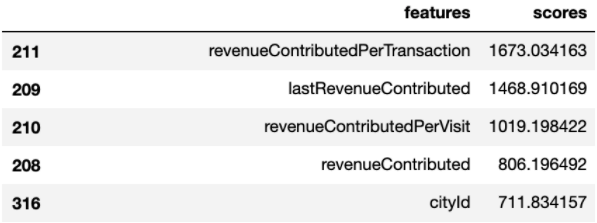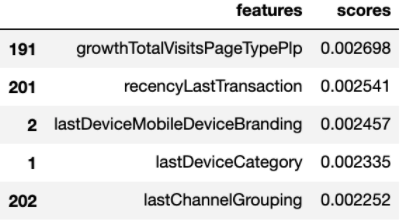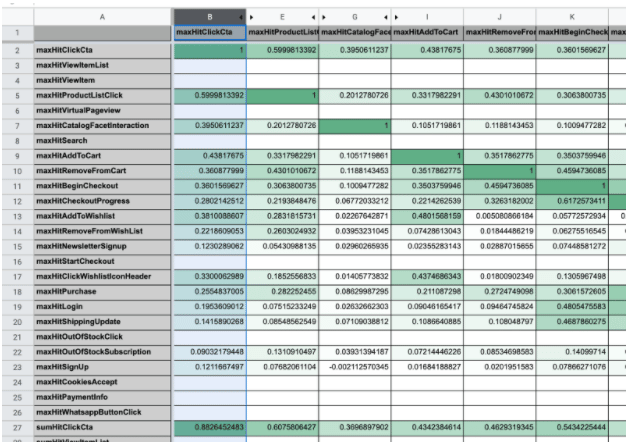Share this
How to Maximize ROI with Conversion Model in Marketing
by Crystalloids Team on Apr 8, 2021 1:10:52 PM
Navigating the world of marketing can be like trying to hit a moving target in the dark. Whether you're a business owner or a marketer, you probably know the challenges of finding and reaching your ideal audience. With the digital world getting more competitive every day, the pressure to make the most of your Return on Investment (ROI) is higher than ever.
In this blog, we'll explore a powerful solution that can help advertisers improve their campaigns: Conversion Models. One effective approach is to focus your marketing efforts on your most valuable audiences, especially those who are more likely to make a purchase.
%20(34).png?width=1120&height=630&name=Blog%20Format%20(1120%20%C3%97%20630px)%20(34).png)
We'll delve into how to predict if customers are likely to buy using machine learning. We'll also see how to use conversion rate data and attribution models to make better marketing decisions. Leveraging the capabilities of the Google Cloud Platform (GCP) and Google Marketing Platform, we'll explore essential topics, including understanding customer behavior, selecting the right data, creating and training your model, and the crucial steps of measuring, implementing, and closely observing it for ongoing success.
This approach allows you to optimize your ad interaction, make informed decisions, and drive better results in the ever-evolving digital landscape.
Predicting Conversion Intent
Imagine being able to spend your digital marketing budget where it matters most, targeting visitors most likely to buy. It might sound like a dream, but predictive modeling can make it a reality.
Predictive modeling means figuring out the patterns in how visitors behave, so you can predict who will convert in the future. For example, someone who visited your site and looked at a lot of pages might be more likely to make a purchase within the next 15 days. This is where a well-made conversion model comes in handy.
Capturing Behavioral Rules
To start with predictive modeling, you need to decide what you want to predict - in this case, conversion intent. But you also need to be clear about the specifics, like what exactly counts as a conversion and the time frame for it.
For instance, if you're a fashion brand selling online, a conversion might mean someone making a purchase within 15 days of visiting your website.
Next, you have to find the data that will help you make these predictions. This data shows you the behavioral patterns you want to understand. Things like customer records, transaction history, and data from tools like Google Analytics can be really helpful. For our fashion brand example, the data we'd want might include:
-
Product value of categories seen in the last visit.
-
Growth of visits in the last 30 days.
-
Device type.
-
Percentage of logged-in visits.
-
Percentage of organic/direct visits.

Selecting the right set of feature variables is critical as it significantly impacts model performance. Consult with a Customer Journey Specialist to ensure you choose the most relevant features for your specific application.
Once you have your data, features, and target defined, you can conduct a feature selection analysis to determine which features contribute to your target and which do not. Eliminating irrelevant or partially relevant features is essential for optimizing your model's performance.
Feature Selection Analysis
Feature selection analysis involves various techniques that can help you understand which features to use in your model, making your modeling techniques better and delivering better results. These techniques include:
Chi-Square Test:
This statistical test looks at the connection between feature variables and your target in the model. If the connection is strong, it means the features are important. For instance, in a conversion intent prediction model, features like revenue-based data and customer location could be an important touchpoint.

Mutual Information:
Mutual information measures how much you learn about the target variable by using a particular feature in your model. Higher scores mean the features are more important. In our example, features connected to how customers behaved in the past might be valuable.

Correlation Matrix:
This matrix shows relationships between features and between features and the target in your model. When features have a positive correlation, it means when one goes up, the other does too. Negative correlations mean the opposite. It's crucial to spot highly correlated features and pick the most relevant ones.
By using these analyses, you can figure out which features are valuable and should be used, which allows marketers to optimize their campaigns. This makes your model more efficient and easier to work with. However, remember that feature selection alone might not guarantee the best performance.

Creating and Training Your Conversion Model
With your feature selection process completed, the next step in building an effective model is creating and training it. This crucial phase involves using the data and selected features to develop a model capable of predicting conversion intent.
Training
To train your model, Google Cloud Platform (GCP) offers various options, such as Vertex AI and BigQuery ML. Given that your data resides in BigQuery and the models you need are available in BigQuery ML, using BigQuery for training is a practical choice.
Standard SQL in BigQuery allows you to create and train your model using a CREATE MODEL statement. You can specify parameters like the model type and the number of iterations, both of which can affect your model's effectiveness. It's advisable to experiment with different settings and use your test dataset to evaluate which configuration works best.
Evaluating
Evaluating the performance of your trained model is crucial to ensure its accuracy and effectiveness. Google BigQuery simplifies this process with the ML.EVALUATE function. This function takes your trained model and the test dataset as input, applies the model to the test data, and generates predictions. These predictions are then compared to the actual labels, determining the accuracy, precision, and recall of your model.
The choice of evaluation metrics may vary depending on your specific scenario. For instance, when using Conversion Intent within Google Audiences, precision may take precedence over recall and accuracy, as you aim to capture all potential converters without missing any. Continuously experimenting with features and parameters while evaluating the model's performance is key to optimizing your model.
Scoring, Deploying, and Monitoring
Now that you've created and trained your model, the next steps are scoring, deploying, and monitoring it for real-time use in Google Marketing Platform.
Scoring and Using the Model in Google Marketing Platform
A trained model is nice, but it has no actual business impact if we don't put it into action. We want to use the model to predict Conversion Intent of visitors on the website. And we want to use these predictions as an Audience in for example Google Ads for retargeting purposes.
We created this Conversion Intent model for a large international fashion retailer. Together, we decided we want to score visitors near-real time so that we could quickly retarget them with the right advertisement. This means that we score visitors every 15 minutes using the last trained model.
Scoring means that we put all the visitor features into the model and get a prediction as a result. This can easily be done with the BigQuery function ML.PREDICT, where you input a table of features (e.g. visitors of the last 15 minutes) and a model (e.g. the last trained model) and you get a prediction as a result. In this case, it is whether someone is likely to convert or not.
These predictions combined with a clientID are pushed to Google Analytics. To be able to do this, we have created a Cloud Function that consists of a Python script that grabs the visitor scores and uses the Measurement Protocol to send these as events to GA. Then in GA marketers can create audiences and put these audiences to action in the Google Marketing Platform.
Retraining & Monitoring the Performance of the Model
The world is ever-changing, and so are our models. To ensure our models stay relevant and effective, we periodically update and retrain them.
For example, in the case of the large fashion retailer, we've set up a model training process in Google Cloud Platform. Using Cloud Functions, we automatically retrain our predictive models once a week. We conduct an automated evaluation, and if the results are satisfactory, the new model replaces the previous one and begins scoring new visitors. This ensures the model always considers the most recent behavioral data when predicting conversion intent.
As part of this process, we also monitor how well our models are performing. As mentioned earlier, the trained model helps us track visitor behavior and their likelihood to convert.
In the following two weeks, we can see whether visitors actually convert or not. By comparing the model's scores with the visitors' actual behavior, we use evaluation metrics like accuracy, precision, and recall to gauge the model's performance. This helps us determine if weekly retraining is sufficient or if we should revisit the entire process, including feature creation, feature selection analysis, and training with different models or parameters, to stay data-driven and continuously improve our model's aggregate performance.
Conclusion
We have explored the essential steps of capturing behavioral rules, performing feature selection analysis, creating and training your conversion model, and scoring, deploying, and monitoring it in Google Cloud Platform and Google Marketing Platform.
Harnessing the power of conversion modeling can help to improve your attribution model, enhance your marketing campaigns, make informed decisions, and drive better results in the dynamic digital landscape. By following these practical insights, you'll be well-equipped to succeed and stay competitive in the ever-evolving world of e-commerce.
Unlock Your Marketing Potential with Crystalloids
Are you ready to take your marketing technology and customer data management to the next level? Crystalloids specializes in building cutting-edge marketing technology solutions and customer data platforms that empower businesses like yours to thrive in the digital age. Our team of experts is dedicated to helping you harness the full potential of your data for more effective marketing strategies. Contact us today to discover how Crystalloids can transform your marketing efforts and drive exceptional results.
Share this
- April 2025 (2)
- February 2025 (2)
- January 2025 (3)
- December 2024 (1)
- November 2024 (5)
- October 2024 (2)
- September 2024 (1)
- August 2024 (1)
- July 2024 (4)
- June 2024 (2)
- May 2024 (1)
- April 2024 (4)
- March 2024 (2)
- February 2024 (2)
- January 2024 (4)
- December 2023 (1)
- November 2023 (4)
- October 2023 (4)
- September 2023 (4)
- June 2023 (2)
- May 2023 (2)
- April 2023 (1)
- March 2023 (1)
- January 2023 (4)
- December 2022 (3)
- November 2022 (5)
- October 2022 (3)
- July 2022 (1)
- May 2022 (2)
- April 2022 (2)
- March 2022 (5)
- February 2022 (3)
- January 2022 (5)
- December 2021 (5)
- November 2021 (4)
- October 2021 (2)
- September 2021 (2)
- August 2021 (3)
- July 2021 (4)
- May 2021 (2)
- April 2021 (2)
- February 2021 (2)
- January 2021 (1)
- December 2020 (1)
- October 2020 (2)
- September 2020 (1)
- August 2020 (2)
- July 2020 (2)
- June 2020 (1)
- March 2020 (2)
- February 2020 (1)
- January 2020 (1)
- December 2019 (1)
- November 2019 (3)
- October 2019 (2)
- September 2019 (3)
- August 2019 (2)
- July 2019 (3)
- June 2019 (5)
- May 2019 (2)
- April 2019 (4)
- March 2019 (2)
- February 2019 (2)
- January 2019 (4)
- December 2018 (2)
- November 2018 (1)
- October 2018 (1)
- September 2018 (2)
- August 2018 (3)
- July 2018 (3)
- May 2018 (2)
- April 2018 (4)
- March 2018 (5)
- February 2018 (2)
- January 2018 (3)
- November 2017 (2)
- October 2017 (2)


